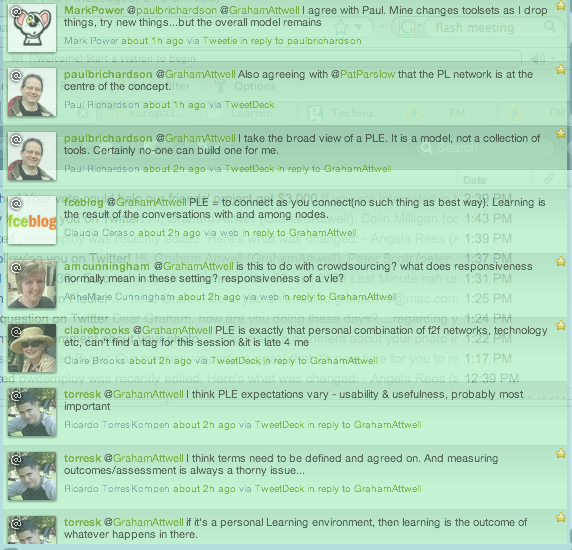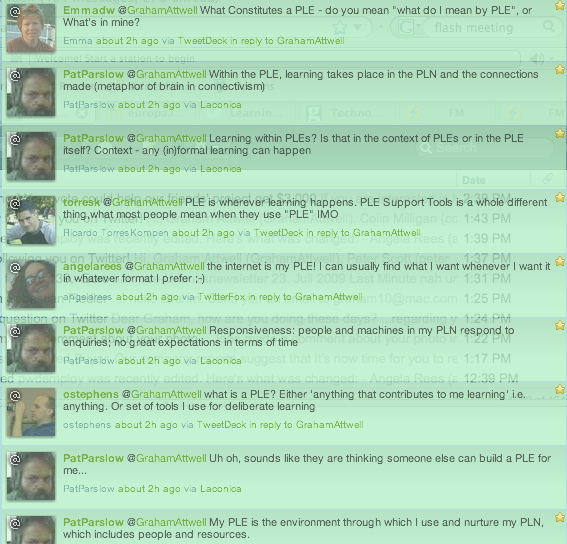Exploring Personal Learning Environments
In September, we organised a symposium on Personal Learning Environments at the the 2nd World Summit on the Knowledge Society (WSKS 2009), “an international attempt to promote the dialogue for the main aspects of the Knowledge Society towards a better world for all.”
I rather rashly promised to publish the products from the symposium. It has taken a little longer than I had hoped, but here they are. The slides and links to the full papers are included in the text, the audio recordings of the presentations can be accessed at the bottom of this page.
The first speaker was Ricardo Torres. His paper was entitled “Using Web 2.0 applications as supporting tools for Personal Learning Environments.”
The abstract is as follows:
” This paper shows the results of a pilot study based on a proposed framework for building Personal Learning Environments using Web 2.0 tools. A group of 33 students from a Business Administration program were introduced to Web 2.0 tools in the context of an Information Systems class, during the academic year 2008-2009, and reflected about this experience through essays and interviews. The responses show evidence of learning and acquiring skills, strengthening social interactions and improvement in the organization and management of content and learning resources.”
You can download his full post here.
The second presentation was was by Cristina Costa from the University of Salford. Her paper was entitled “Teachers professional development through Web 2.0 environments.
Her abstract reads as follows:
“Teacher professional development is no longer synonymous with acquiring new teaching techniques, it is rather about starting new processes as to engage with new forms of learning, reflected in the practice of teaching. With easy access to the panoply of online communications tools, new opportunities for further development have been enabled. Learning within a wider community has not only become a possibility, but rather a reality accessible to a larger number of individuals interested in pursuing their learning path both in a personalised and networked way. The web provides the space for learning, but the learning environment is decidedly dependent on the interrelationships that are established amongst individuals. The effectiveness of the web is reflected in the unconventional opportunities it offers for people to emerge as knowledge producers rather than information collectors. Hence, it is not the tools that most matter to develop a learning environment where more personalized learning opportunities and collective intelligence prospers as the result of personal and collaborative effort. Although web tools provide the space for interaction, it is the enhancement of a meaningful learning atmosphere, resulting in a joint enterprise to learn and excel in their practice, which will transform a space for learning into an effective, interactive learning environment. The paper will examine learning and training experiences in informal web environments as the basis for an open discussion about professional development in web 2.0 environments.”
You can download her full paper here.
The third presentation was by Tobias Nelkner from the University of Paderborn. He talked about the development of a widget infrastructure to support Personal Learning Environments. Here is his abstract:
“Widget based mashups seem to be a proper approach to realise self-organisable Personal Learning Environments. In comparison to integrated and monolithic pieces of software developed for supporting certain workflows, widgets provide small sets of functionality. The results of one widget can hardly be used in other widgets for further processing. In order to overcome this gap and to provide an environment allowing easily developing PLEs with complex functionality, the based on the TenCompetence Widget Server [1], we developed a server that allows widgets to exchange data. This key functionality allows developers to create synergetic effects with other widgets without increasing the effort of developing widgets nor having to deal with web services or similar techniques. Looking for available data and events of other widgets, developing the own widget and uploading it to the server is an easy way publishing new widgets. With this approach, the knowledge worker is enabled to create a PLE with more sophisticated functionality by choosing the combination of widgets needed for the current task. This paper describes the Widget Server developed within the EU funded IP project Mature, which possibilities it provides and which consequences follow for widget developer.
You can download his full paper here.
The fourth was Maria Perifanou from the University of Athens. She talked of her experiences of using microblogging for language learning. the abstract reads:
‘Learning is an active process of constructing rather than acquiring knowledge and instruction is a process of supporting that construction rather than communicating knowledge’. Can this process of learning be fun for the learner? Successful learning involves a mixture of work and fun. One of the recent web 2.0 services that can offer great possibilities for learning is Microblogging. This kind of motivation can raise students’ natural curiosity and interest which promotes learning. Play can also promote excitement, enjoyment, and a relaxing atmosphere. As Vygotsky (1933) advocates, play creates a zone of proximal development (ZDP) in children. According to Vygotsky, the ZDP is the distance between one’s actual developmental level and one’s potential developmental level when interacting with someone and/or something in the social environment. Play can be highly influential in learning. What happens when play becomes informal learning supported by web 2.0 technologies? Practical ideas applied in an Italian foreign language classroom using microblogging to promote fun and informal learning showed that microblogging can enhance motivation.”
Maria’s full paper can be downloaded here.
The final speaker was Graham Attwell from Pontydysgu. He talked about the European Commission Mature-IP project which is developing a Personal Learning and Maturing Environment. His paper was jointly authored with John Cook and andrew Ravenscroft from the Metropolitan University of London. Here is the abstract:
“The development of Technology Enhanced Learning has been dominated by the education paradigm. However social software and new forms of knowledge development and collaborative meaning making are challenging such domination. Technology is increasingly being used to mediate the development of work process knowledge and these processes are leading to the evolution of rhizomatic forms of community based knowledge development. Technologies can support different forms of contextual knowledge development through Personal Learning Environments. The appropriation or shaping of technologies to develop Personal Learning Environments may be seen as an outcome of learning in itself. Mobile devices have the potential to support situated and context based learning, as exemplified in projects undertaken at London Metropolitan University. This work provides the basis for the development of a Work Orientated MoBile Learning Environment (WOMBLE).”
You can download the paper here.
Podcast music is ‘Miss is a sea fish’ by Ehma from the Jamendo web site.
Podcast: Play in new window | Download
Subscribe: RSS
Podcast (podcast1): Play in new window | Download
Subscribe: RSS
Podcast (podcast2): Play in new window | Download
Subscribe: RSS
Podcast (podcast3): Play in new window | Download
Subscribe: RSS


